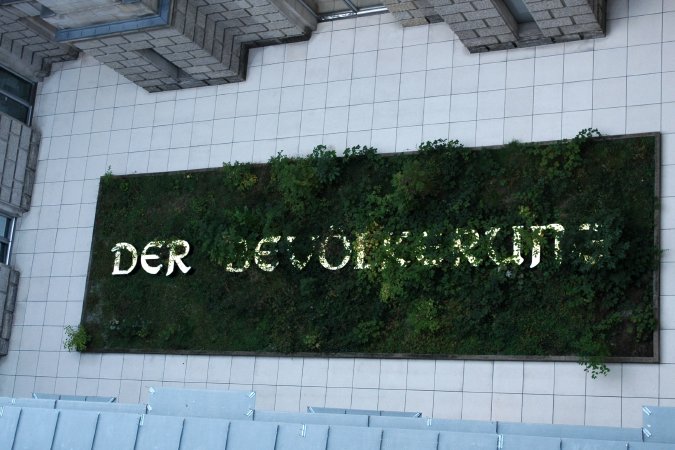Der amerikanischen Bevölkerung

Hans Haacke, Der Bevölkerung (1999/2000)
Hans Haacke's bold transformation of an interior courtyard dedicates the German Reichstag to Der Bevölkerung. A play on the Reichstag's original dedication, Dem Deutschen Völke (To the German People), Der Bevölkerung pledges the symbol of new German democracy "To the Population." It is literally a monument to demography, a science known to German-speaking people as Bevölkerungsstatistik.
New York Times columnist David Brooks has identified a demographic monument befitting Dem Amerikanischen Völke: the 2008 Democratic presidential campaign. The rise of "a mass educated class" has separated "[t]he college educated and non-college educated" into "different towns." The two classes have "radically different divorce rates and starkly different ways of raising their children." Far beyond "the ideological divide between Red and Blue America," we now behold a "a deep cultural gap within the Democratic Party, separating what Stuart Rothenberg calls the two Democratic parties":
The different segments of the American Volk — what I would call (in the nominative case) die amerikanische Bevölkerung — divide themselves less according to political ideology and more according to education and class. Brooks asserts that "people in different niches have developed different unconscious maps of reality" and "different communal understandings of what constitutes a good leader, of what sort of world they live in." Their "different communal definitions, which they can’t even articulate, of what they mean by liberty, security and virtue" have functionally separated demographic groups in America into distinct "tribes or cultures.In state after state (Wisconsin being the outlier), Barack Obama has won densely populated, well-educated areas. Hillary Clinton has won less-populated, less-educated areas. For example, Obama has won roughly 70 percent of the most-educated counties in the primary states. Clinton has won 90 percent of the least-educated counties. In state after state, Obama has won a few urban and inner-ring suburban counties. Clinton has won nearly everywhere else.
Brooks finds a certain "poignancy" in this phenomenon. There's even a MoneyLaw dimension to it:
[E]ven if you take away the ideological differences between the parties, you are still left with profound social gulfs within the parties. There’s poignancy to that. The upscale liberals who revere Obama have spent their lives championing equality and opposing privilege. But they’ve smashed the old WASP social hierarchy only to create a new educational one.Meet the new boss. Same as the old boss. Let's not get fooled again.













1 Comments:
I don't understand the importance of Brooks' observation. So one group of people within a party prefers one candidate over another. So what?
The Republican party has had multiple schisms for many years, divided between very well-educated, rich "captains of industry," and poor, uneducated "Heartland" voters. Then there's the divide, sometimes along the same lines, between the ultra-religious values voters and those that vote purely out of economic selfishness.
Brooks is no sociologist. The groups he lumps people into are broad and meaningless, based on weak statistical evidence, vulnerable to the whims of the news cycle, and generalized to the point of silliness.
Post a Comment
<< Home